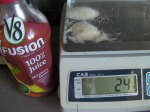
How much?
My new students, regardless of age or cooking experience, begin with a quick reference to measurements as they pertain to the size of the hand. Their hand to be specific. They made measuring cups and spoons long after women had been cooking and men had been flipping meat over an open fire, and based the measurements on women’s hands.
Something else to know and consider: In the U.S. all recipes and reference to amounts are in pounds and ounces EXCEPT nutritional information on packaging, these are in Imperial measurements, grams and millimeters. Until I bought a scale, I didn’t fully comprehend the amount of salt and sugar (or anything else for that matter) listed in the nutritional information on packages or in the medical community guidelines.
Here is a chart to give a better understanding to the term: “size matters” as it pertains to servings of good health.
For Nutritional Servings per day:
Raw Vegetables, Piece of Fruit, Cereal
(Woman’s fist or Baseball)
Latest Comments